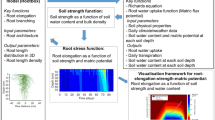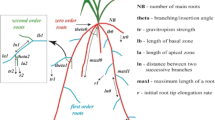Abstract
Most existing water and nutrient uptake models are based on the assumption that roots are evenly distributed in the soil volume. This assumption is not realistic for field conditions, and significantly alters water or nutrient uptake calculations. Therefore, development of models of root system growth that account for the spatial distribution of roots is necessary.
The objective of this work was to test a three dimensional architectural model of the maize root system by comparing simulated horizontal root maps with observed root maps obtained from the field. The model was built using the current knowledge on maize root system morphogenesis and parameters obtained under field conditions. Simulated root maps (0.45 × 0.75 m) of horizontal cross sections at 3 depths and 3 dates were obtained by using the model for a plant population. Actual root maps were obtained in a deep, barrier-free clay-loamy soil by digging pits, preparing selected horizontal planes and recording root contacts on plastic sheets.
Results showed that both the number of cross-sections of axile roots, and their spatial distribution characterized with the R-index value of Clark and Evans (1954), were correctly accounted for by the model at all dates and depths. The number of cross-sections of laterals was also correctly predicted. However, laterals were more clustered around axile roots on simulated root maps than on observed root maps. Although slight discrepancies appeared between simulated and observed root maps in this respect, it was concluded that the model correctly accounted for the general colonization pattern of the soil volume by roots under a maize crop.
Similar content being viewed by others
References
Barber S A 1984 Soil Nutrient Bioavailability: A Mechanistic Approach. Wiley-Interscience, New York. 398p.
Brouder S M and Cassman K G 1994 Evaluation of a mechanistic model of potassium uptake by cotton in vermicultic soil. Soil Sci. Soc. Am. J. 58, 1174–1183.
Bruckler L, Lafolie F and Tardieu F 1991 Modeling root water potential and soil-root water transport: II. Field comparisons. Soil Sci. Soc. Am. J. 55, 1213–1220.
Cahn M D, Zobel R W and Bouldin D R 1989 Relationship between root elongation rate and diameter and duration of growth of lateral roots of maize. Plant and Soil 119, 271–279.
Clark P J and Evans F C 1954 Distance to nearest neighbor as a measure of spatial relationships in populations. Ecology 35, 445–453.
Clausnitzer V and Hopmans J W 1994 Simultaneous modeling of transient three-dimensional root growth and soil water flow. Plant and Soil 164, 299–314.
De Willigen P and Van Noordwijk M 1987 Roots, plant production and nutrient use efficiency. PhD Thesis. Wageningen Agricultural University, Wageningen, The Netherlands, 282p.
DeWilligen P and VanNoordwijk M 1987 Uptake potential of nonregularly distributed roots. J. Plant Nutr. 10, 1273–1280.
Diggle A J 1988 ROOTMAP- a model in three-dimensional coordinates of the growth and structure of fibrous root systems. Plant and Soil 105, 169–178.
Durand R, Bonhomme R and Derieux M 1982 Seuil optimal des sommes de températures: Application au maîs (Zea mays L.). Agronomie 2, 589–597.
Girardin P, Jordan M O, Picard D and Trendel R 1986 Harmonisation des notations concernant la description morphologique d'un pied de maîs (Zea mays L.). Agronomie 6, 873–875.
Hanway J J 1963 Growth stages of corn (Zea mays L.). Agron. J. 55, 487–491.
Hillel D, VanBeek C G and Talpaz H 1975 A microscopic-scale model of soil water uptake and salt movement to plant roots. Soil Sci. 120, 385–399.
Lafolie F, Bruckler L and Tardieu F 1991 Modeling root water potential and soil-root water transport: I. Model presentation. Soil Sci. Soc. Am. J. 55, 1203–1212.
Logsdon S D and Allmaras R R 1991 Maize and soybean root clustering as indicated by root mapping. Plant and Soil 131, 169–176.
Lu S and Miller M H 1994 Prediction of phosphorus uptake by field-grown maize with the Barber-Cushman model. Soil Sci. Soc. Am. J. 58, 852–857.
Mengel D B and Barber S A 1974 Development and distribution of the corn root system under field conditions. Agron. J. 66, 341–345.
Pagès L, Jordan M O and Picard D 1989 A simulation model of the three-dimensional architecture of the maize root system. Plant and Soil 119, 147–154.
Pagès L and Pellerin S 1994 Evaluation of parameters describing the root system architecture of field grown maize plants (Zea mays L.). II. Density, length, and branching of first-order lateral roots. Plant and Soil 164, 169–176.
Pellerin S, Tricot F and Chadoeuf J 1989 Disposition des racines adventives autour de la tige de maîs (Zea mays L.). Agronomie 9, 859–866.
Pellerin S 1993 Rate of differentiation and emergence of nodal maize roots. Plant and Soil 148, 155–161.
Pellerin S and Pagès L 1994 Evaluation of parameters describing the root system architecture of field grown maize plants (Zea mays L.). I. Elongation of seminal and nodal roots and extension of their branched zone. Plant and Soil 164, 155–167.
SAS Institute, Inc. 1988 SAS user's guide. SAS Inst., Inc., Cary, NC.
Sinclair D F 1985 On tests of spatial randomness using mean nearest neighbor distance. Ecology 66, 1084–1085.
Tardieu F 1988 Analysis of spatial variability of maize root density. I. Effect of wheel compaction on the spatial arrangement of roots. Plant and Soil 107, 259–266.
Tardieu F 1988 Analysis of spatial variability of maize root density. III. Effect of a wheel compaction on water extraction. Plant and Soil 109, 257–262.
Tardieu F, Bruckler L and Lafolie F 1992 Root clumping may affect the root water potential and the resistance to soil-root water transport. Plant and Soil 140, 291–301.
Tardieu F and Pellerin S 1990 Trajectory of the nodal roots of maize in fields with low mechanical constraints. Plant and Soil 124, 39–45.
Tardieu F and Pellerin S 1991 Influence of soil temperature during root appearance on the trajectory of nodal roots of field grown maize. Plant and Soil 131, 207–214.
VanRees K C J, Hoskins J A and Hoskins W D 1994 Analyzing root competition with dirichlet tessellation for wheat on three landscape positions. Soil Sci. Soc. Am. J. 58, 423–432.
Varney G T, Canny M J, Wang X L and McCully M E 1991 The branch roots of Zea. I. First order branches, their number, sizes and division into classes. Ann. Bot. 67, 357–364.
Yanai R D 1994 A steady-state model of nutrient uptake accounting for newly grown roots. Soil Sci. Soc. Am. J. 58, 1562–1571.
Author information
Authors and Affiliations
Rights and permissions
About this article
Cite this article
Pellerin, S., Pagès, L. Evaluation in field conditions of a three-dimensional architectural model of the maize root system: Comparison of simulated and observed horizontal root maps. Plant Soil 178, 101–112 (1996). https://doi.org/10.1007/BF00011168
Received:
Accepted:
Issue Date:
DOI: https://doi.org/10.1007/BF00011168




